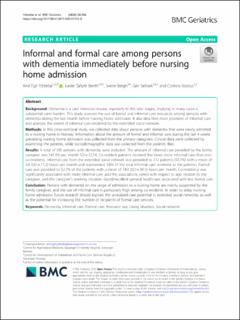| dc.contributor.author | Ydstebø, Arnt Egil | |
| dc.contributor.author | Saltyte Benth, Jurate | |
| dc.contributor.author | Bergh, Sverre | |
| dc.contributor.author | Selbæk, Geir | |
| dc.contributor.author | Vossius, Corinna Elisabeth | |
| dc.coverage.spatial | Norway | en_US |
| dc.date.accessioned | 2023-04-12T14:10:54Z | |
| dc.date.available | 2023-04-12T14:10:54Z | |
| dc.date.created | 2020-08-25T15:22:42Z | |
| dc.date.issued | 2020 | |
| dc.identifier.citation | BMC Geriatrics. 2020, 20 (1), . | en_US |
| dc.identifier.issn | 1471-2318 | |
| dc.identifier.uri | https://hdl.handle.net/11250/3062731 | |
| dc.description.abstract | Background: Dementia is a care intensive disease, especially in the later stages, implying in many cases a substantial carer burden. This study assesses the use of formal and informal care resources among persons with dementia during the last month before nursing home admission. It also describes main providers of informal care and assesses the extent of informal care rendered by the extended social network. Methods: In this cross-sectional study, we collected data about persons with dementia that were newly admitted to a nursing home in Norway. Information about the amount of formal and informal care during the last 4 weeks preceding nursing home admission was collected from the primary caregivers. Clinical data were collected by examining the patients, while sociodemographic data was collected from the patients' files. Results: A total of 395 persons with dementia were included. The amount of informal care provided by the family caregiver was 141.9 h per month SD = 227.4. Co-resident patients received five times more informal care than non-co-residents. Informal care from the extended social network was provided to 212 patients (53.7%) with a mean of 5.6 (SD = 11.2) hours per month and represented 3.8% of the total informal care rendered to the patients. Formal care was provided to 52.7% of the patients with a mean of 18.0 (SD = 50.1) hours per month. Co-residency was significantly associated with more informal care, and the associations varied with respect to age, relation to the caregiver, and the caregiver's working situation. Good/excellent general health was associated with less formal care. Conclusion: Persons with dementia on the verge of admission to a nursing home are mainly supported by the family caregiver, and the use of informal care is particularly high among co-residents. In order to delay nursing home admission, future research should explore the unrealized care potential in extended social networks, as well as the potential for increasing the number of recipients of formal care services. Keywords: Dementia; Formal care; Informal care; Living situation; Resource use; Social network. | en_US |
| dc.description.sponsorship | The data collection was administrated by the Research Centre for Age related Functional decline and Disease, Innlandet Hospital Trust, and was initiated by the Norwegian Health Directorate, which also provided funding.
The funding body had no role in decisions regarding the design, analysis or interpretation of the present study. | en_US |
| dc.language.iso | eng | en_US |
| dc.relation.uri | https://www.ncbi.nlm.nih.gov/pmc/articles/PMC7436969/pdf/12877_2020_Article_1703.pdf | |
| dc.rights | Navngivelse 4.0 Internasjonal | * |
| dc.rights.uri | http://creativecommons.org/licenses/by/4.0/deed.no | * |
| dc.subject | Dementia; | en_US |
| dc.subject | Formal care; | en_US |
| dc.subject | Informal care; | en_US |
| dc.subject | Living situation; | en_US |
| dc.subject | Resource use; | en_US |
| dc.subject | Social network. | en_US |
| dc.title | Informal and formal care among persons with dementia immediately before nursing home admission | en_US |
| dc.type | Peer reviewed | en_US |
| dc.type | Journal article | en_US |
| dc.description.version | publishedVersion | en_US |
| dc.rights.holder | © The Author(s). 2020 Open Access. This article is licensed under a Creative Commons Attribution 4.0 International License, which permits use, sharing, adaptation, distribution and reproduction in any medium or format, as long as you give appropriate credit to the original author(s) and the source, provide a link to the Creative Commons licence, and indicate if changes were made. | en_US |
| dc.source.pagenumber | 9 | en_US |
| dc.source.volume | 20 | en_US |
| dc.source.journal | BMC Geriatrics | en_US |
| dc.source.issue | 1 | en_US |
| dc.identifier.doi | 10.1186/s12877-020-01703-8 | |
| dc.identifier.cristin | 1825095 | |
| cristin.ispublished | true | |
| cristin.fulltext | original | |
| cristin.qualitycode | 1 | |

